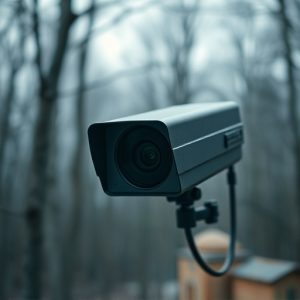Spy Camera AI Integration: Placement, Ethics, & Effective Network Maintenance
TL;DR:The integration of Spy Camera Artificial Intelligence (AI) revolutionizes security technology…….
TL;DR:
The integration of Spy Camera Artificial Intelligence (AI) revolutionizes security technology with real-time anomaly detection, facial recognition, and threat prediction. This enhances surveillance efficiency by automating alerts for suspicious activity, optimizing camera placement, and minimizing false positives. AI-driven systems analyze environments, predict behavior, and strategically place cameras for comprehensive yet undetectable coverage. While raising ethical and legal concerns regarding privacy, responsible implementation includes transparency, consent, and adherence to regulations like GDPR. Regular maintenance, enabled by AI, ensures long-term network effectiveness through anomaly detection, adaptive video settings, and efficient storage management.
“Uncover the art of covert camera network installation with our comprehensive guide. In an era where artificial intelligence (AI) integration in spy cameras is transforming surveillance, understanding best practices is paramount. From selecting the ideal locations for these concealed eyes to navigating ethical and legal complexities, this article offers insights. Learn how AI enhances camera capabilities and ensures optimal performance. Discover the importance of regular maintenance and monitoring for a robust network. Master the subtle art of installation, ensuring both privacy and security.”
- Understanding Spy Camera Artificial Intelligence Integration
- Choosing the Right Location for Covert Cameras
- Ethical Considerations and Legal Implications
- Maintaining and Monitoring Your Network Effectively
Understanding Spy Camera Artificial Intelligence Integration
The integration of Spy Camera Artificial Intelligence (AI) represents a significant leap forward in security and surveillance technology. AI algorithms can analyze live footage, detect anomalies, recognize faces or objects, and even predict potential threats—all in real-time. This advanced capability transforms the way spy camera networks are utilized, enhancing their efficiency and effectiveness. For example, AI can automatically trigger alerts when suspicious activity is detected, allowing for swift response times and minimizing false positives.
Understanding how this technology works is crucial for optimal network installation. The placement of cameras becomes more strategic when AI integration is considered, as the system’s learning capabilities can fill in gaps left by human oversight. Additionally, AI-driven analytics provide valuable insights, enabling better data-backed decisions regarding network expansion or refinement. This cutting-edge approach ensures that spy camera networks are not just passive recorders but active contributors to enhanced security measures.
Choosing the Right Location for Covert Cameras
When selecting locations for covert camera network installation, it’s crucial to leverage the power of Spy Camera Artificial Intelligence Integration. AI-driven systems can analyze environments, predict human behavior, and identify optimal viewpoints for maximum coverage and minimal detection. For instance, placing cameras near common access points like doors or windows, or in areas with high foot traffic, can provide comprehensive surveillance without raising suspicion.
Consider the environment’s lighting conditions, angles, and potential obstacles when choosing camera positions. AI algorithms can help navigate these challenges by adjusting settings and perspectives dynamically to ensure clear, consistent footage. By combining advanced technology with strategic placement, you can create an effective covert network that captures crucial details while remaining virtually undetectable.
Ethical Considerations and Legal Implications
The installation of a covert camera network raises significant ethical considerations and legal implications that must be carefully navigated. As technology advances, with the integration of spy cameras and artificial intelligence, it becomes increasingly important to balance privacy rights with security needs. The use of such devices can infringe on individual privacy if not implemented responsibly. This includes ensuring transparency about their presence, obtaining proper consent, and limiting data collection to what is absolutely necessary for the stated purpose.
Legally, there are strict regulations governing the installation and use of surveillance equipment. These laws vary by jurisdiction but generally require explicit authorization, especially for hidden cameras. Organizations deploying covert networks must comply with data protection acts, such as GDPR in Europe, which govern how personal information is handled. Additionally, they must be mindful of potential misuse or unauthorized access to collected data, which could lead to severe legal consequences and damage to reputational standing.
Maintaining and Monitoring Your Network Effectively
Regular maintenance and monitoring are crucial for a covert camera network’s long-term effectiveness. By integrating Spy Camera Artificial Intelligence, you can streamline this process, enhancing overall performance. AI-driven systems can automatically detect anomalies, such as unauthorized access attempts or equipment malfunctions, alerting you in real time via smart notifications. This proactive approach enables swift action to resolve issues before they escalate.
Additionally, these intelligent networks can optimize video quality and storage efficiency through adaptive settings based on environmental conditions. For instance, AI algorithms can enhance night vision, improve image clarity during low-light conditions, and dynamically adjust recording resolution based on movement detected in the field of view. Efficient monitoring and adaptive features contribute to a robust security network that remains effective over time.
The installation of a covert camera network, enhanced by Spy Camera Artificial Intelligence Integration, requires a delicate balance between security enhancement and ethical considerations. Choosing strategic locations, adhering to legal guidelines, and implementing effective monitoring practices are paramount. By following best practices outlined in this article, you can ensure your network not only provides comprehensive surveillance but also respects privacy rights, ultimately striking a safe and lawful equilibrium.


